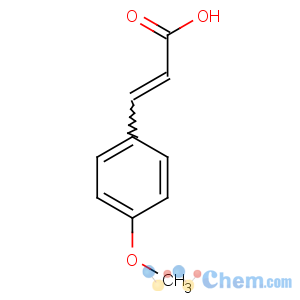4-Methoxycinnamic acid
-
- Product Name4-Methoxycinnamic acid
- CAS No.830-09-1
- Purity98%
- Min Quantity
- Price~

 View Contact Detail
View Contact Detail
-
 Molecular Structure
Molecular Structure
Detailed Description
English name: 4-Methoxycinnamic acidOther names: 4-methoxycinnamate, 4-Methoxyciamic acid, 4-MethoxyClnnamic acid
CAS No.: 830-09-1
Molecular weight: 178.18 g/mol
Molar mass: 178.062994 g/mol,
Melting point: 173.5 °C(lit.)
Boiling point: 250.41°C (rough estimate)
Flash point: 138.6±14.4 °C
Refractive index: 1.591
Properties: White crystal Novochemy
Purity: 98%
Packaging: Seal
Storage method: Keep the container sealed and store in a cool, dry place
Usage:
Used in various cosmetic formulations in sunscreen products.
Methoxycinnamic acidis mainly used as an important intermediate in organic synthesis; P-MCA exerted antihyperglycemic/hypoglycemic effect by stimulating insulin secretion from pancreas and could be developed into a new potential for therapeutic agent used in type 2 diabetic patients. It shows various pharmacologic actions such as hepatoprotective and antihyperglycemic activities, it also can stimulate insulin secretion from pancreatic β-cells by increasing Ca2+ influx via the L-type Ca2+ channels, but not through the closure of ATP-sensitive K+ channels. 4-Methoxycinnamic acid can strongly inhibit the diphenolase activity of mushroom tyrosinase, with the IC 50 value of 0.42 mM, and the inhibition is reversible. Inhibitory effects of cinnamic acid and its derivatives on the diphenolase activity of mushroom ( Agaricus bisporus ) tyrosinase. Natural products modulate Shigella-host-cell interaction. Photosensitive semiconductor nanocrystals, photosensitive composition comprising semiconductor nanocrystals and method for forming semiconductor nanocrystal pattern using the same. Mechanisms of p-methoxycinnamic acid-induced increase in insulin secretion. Protective effect of p-methoxycinnamic acid, an active phenolic acid against 1,2-dimethylhydrazine-induced colon carcinogenesis: modulating biotransforming bacterial enzymes and xenobiotic metabolizing enzymes.